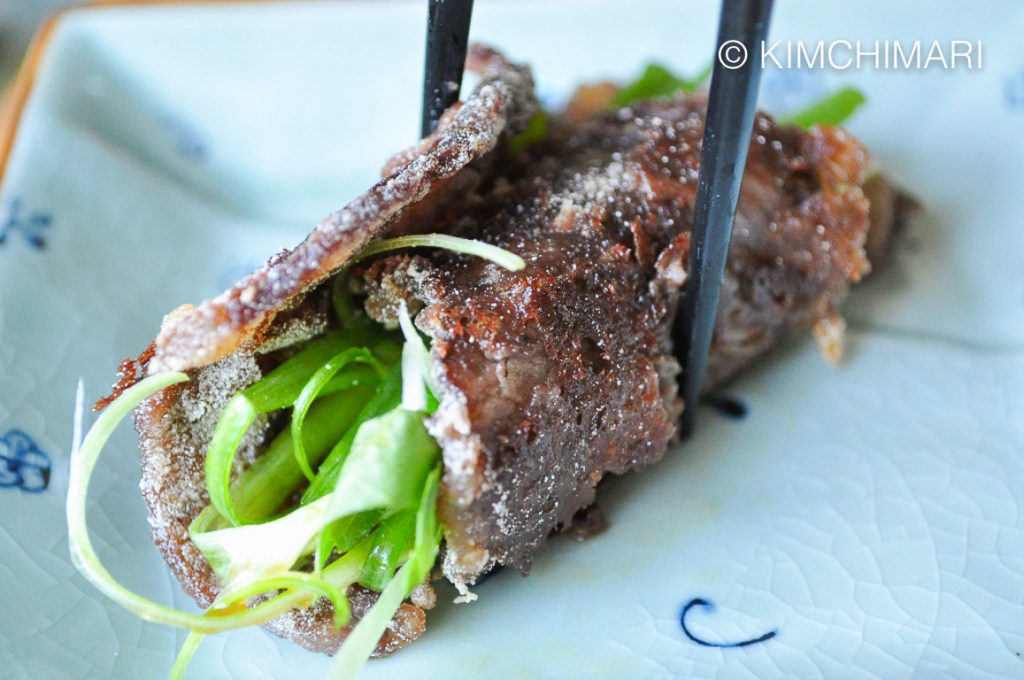
Sweet Rice Bulgogi is bulgogi that is crispy and delicious!
Since my dad was a diplomat, we often entertained foreign guests in our home when I was growing up in Korea. A fabulous chef called Mrs. Shim would come to our house and make wonderful Korean dishes for these occasions. Her food was at a whole different level, not only the taste but always looked so elegant when served. Sweet Rice Bulgogi was one of her specialty dishes and I just absolutely loved it! I never got to learn the recipe from her since I was just a kid… Over the years, I kind of forgot all about it until I got married and wanted to make something special for my family. So.. I created and worked on this recipe from memory and I have to say it’s pretty darn close!
Chapsal Bulgogi or Sweet rice Bulgogi is not a dish commonly found in your average Korean home and there are very few restaurants even in Seoul that serve this dish. I actually searched Korean websites and found only few recipes–none of them like my version here. Other recipes all marinate the beef first (same as regular bulgogi) and then coat it with sweet rice flour before frying in plain oil.
Anyway, this dish has become our family’s absolute favorite. My husband is so excited to have this dish that he is always eager to help with coating and frying the bulgogi. He says this way I can make the sauce and prepare the vegetables at the same time and we can eat our dinner that much sooner! 🙂
Korean (Oriental) Yellow Mustard (겨자 Gyeoja)
Koreans love to use Gyeoja in sauces and you can purchase ready-made tubes from the Korean store or online (like here on my Amazon store). But I find that these are just not as spicy and full of flavor like the ones you make at home. I like to buy Oriental HOT Mustard Powder like the one below and make the paste myself.
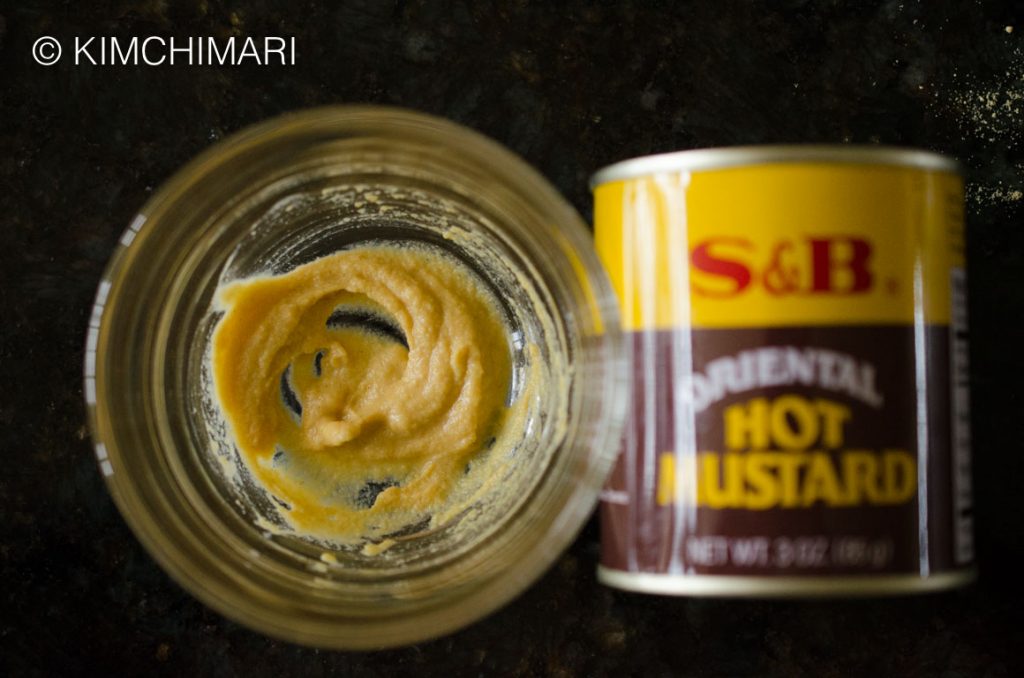
It’s really easy – just add some powder, add some warm water (follow directions on can) and make a paste like you see in the picture. Let it sit for few minutes until the full flavor develops.
Preparation time: 30 min.
Cooking time: it tastes best when you cook and eat, cook and eat… so it’s hard to say how long it takes but each piece should take no longer than 2-3 min which means you can have about 5-6 pieces cooked in about 6 min. or so.
Servings: 2
Ingredients
- 1 lb thinly sliced top sirloin or other tenderloin
- 2/3 C sweet rice flour (just need enough to coat)
- 6-8 green onions (thinly sliced)
- 1 C sliced perilla leaves (optional)
- sesame oil for pan frying
- salt and pepper
Ingredients for Sauce
- 3 T kikomman soy sauce
- 1 T sugar
- 4 tsp honey
- 1/4 to 1/3 tsp oriental hot mustard (made from mixing yellow mustard powder)
- 1 tsp chopped pine nuts
Directions
0. If you don’t have a tube mustard, make your own mustard paste from powder. Read my section on Korean Yellow Mustard above.
1. Season the thinly sliced sirloin pieces (cut for bulgogi) with salt and pepper. It’s easiest to start when the pieces are still a bit frozen where the individual pieces are still stiff but defrosted enough that each piece falls apart easily. Season each piece by sprinkling some salt and pepper onto them and layering them onto a wide plate.

2. Once all the beef pieces are seasoned, coat each piece in sweet rice flour and set aside. The product I use is Koda Farms, Mochiko flour. You can find this in both oriental and American supermarkets.
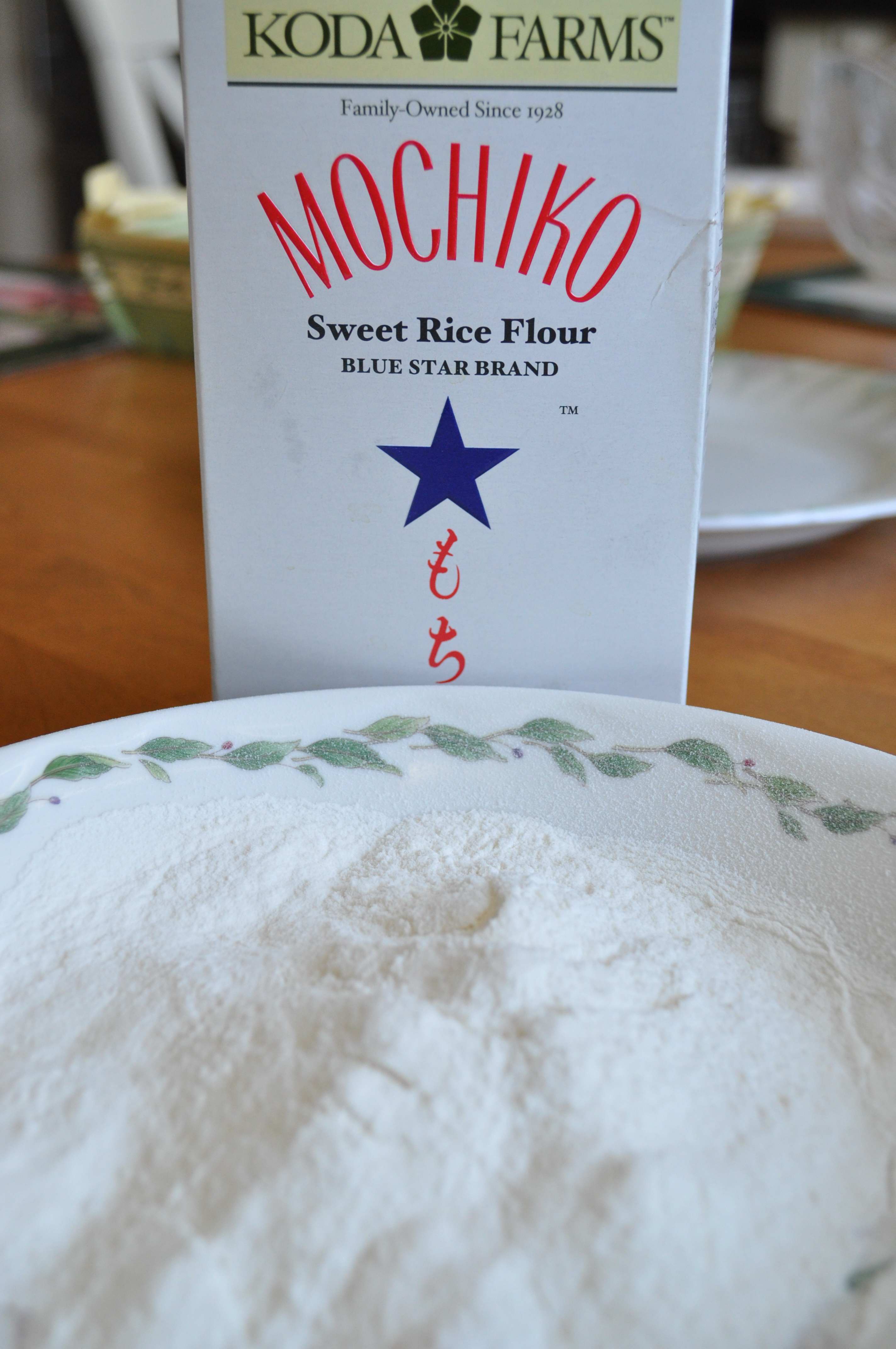
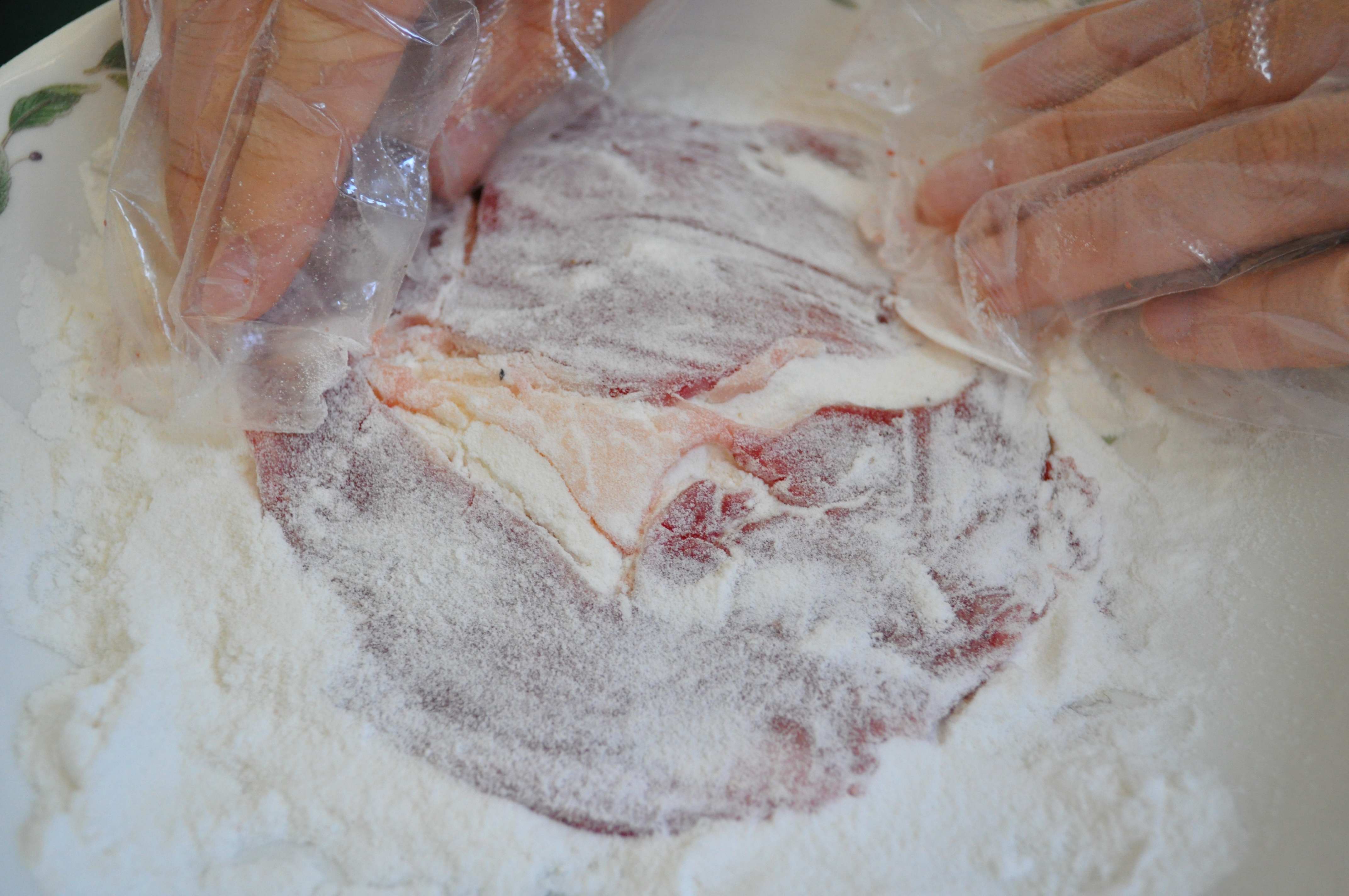
Wearing plastic gloves to coat the beef keeps your hands clean!

3. Chapsal bulgogi tastes best when it’s hot so it’s a good idea to prepare the vegetables and the sauce before you start cooking the meat. If your meat is too frozen, you can work on the sauce and veggies even before you coat the meat.
Wash and clean the green onions. Thinly slice the green onions by cutting them into approx. 2 in long pieces and then slicing each piece thinly as shown below. This is not the only way to do it but I found (over the years) this is one of the easiest and quickest way to do it. This is called 파채(pache) and it serves as a condiment to many meat dishes.
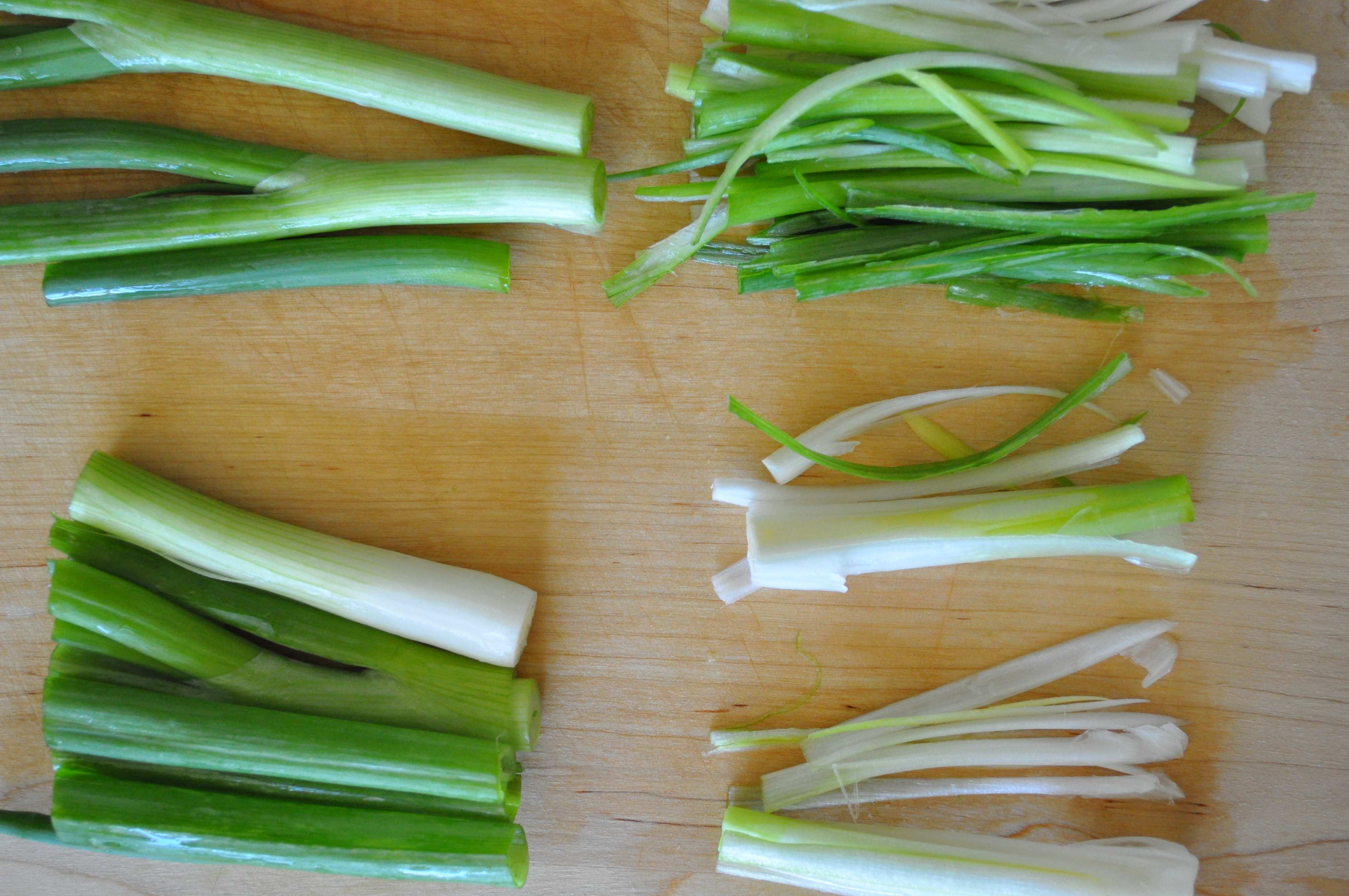
Soak them in cold water for 5 min. or more. Soaking takes away the strong taste of raw onions and also makes them extra crunchy. The green onion pieces will start to curl up as shown below. Drain and serve.
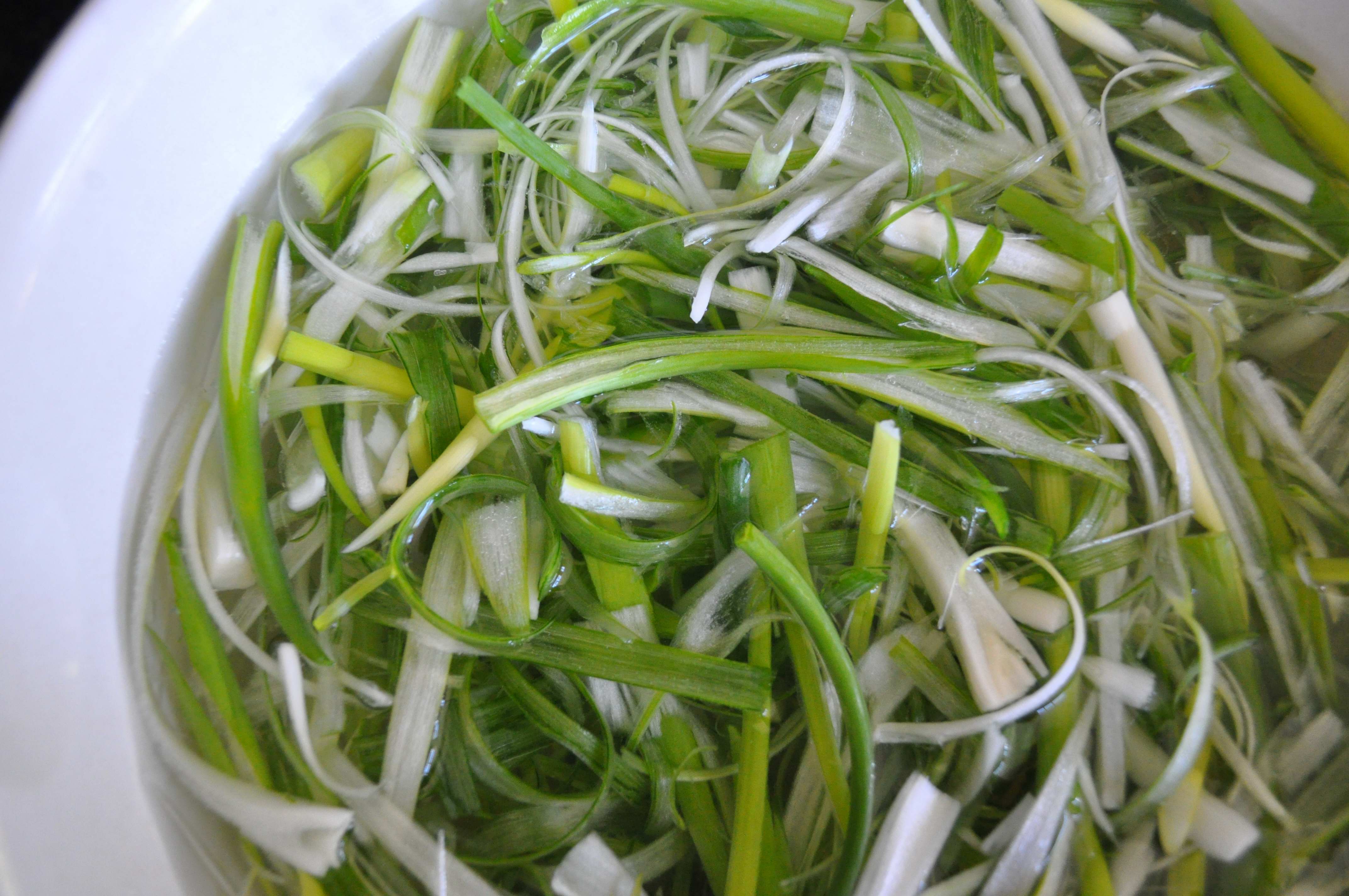
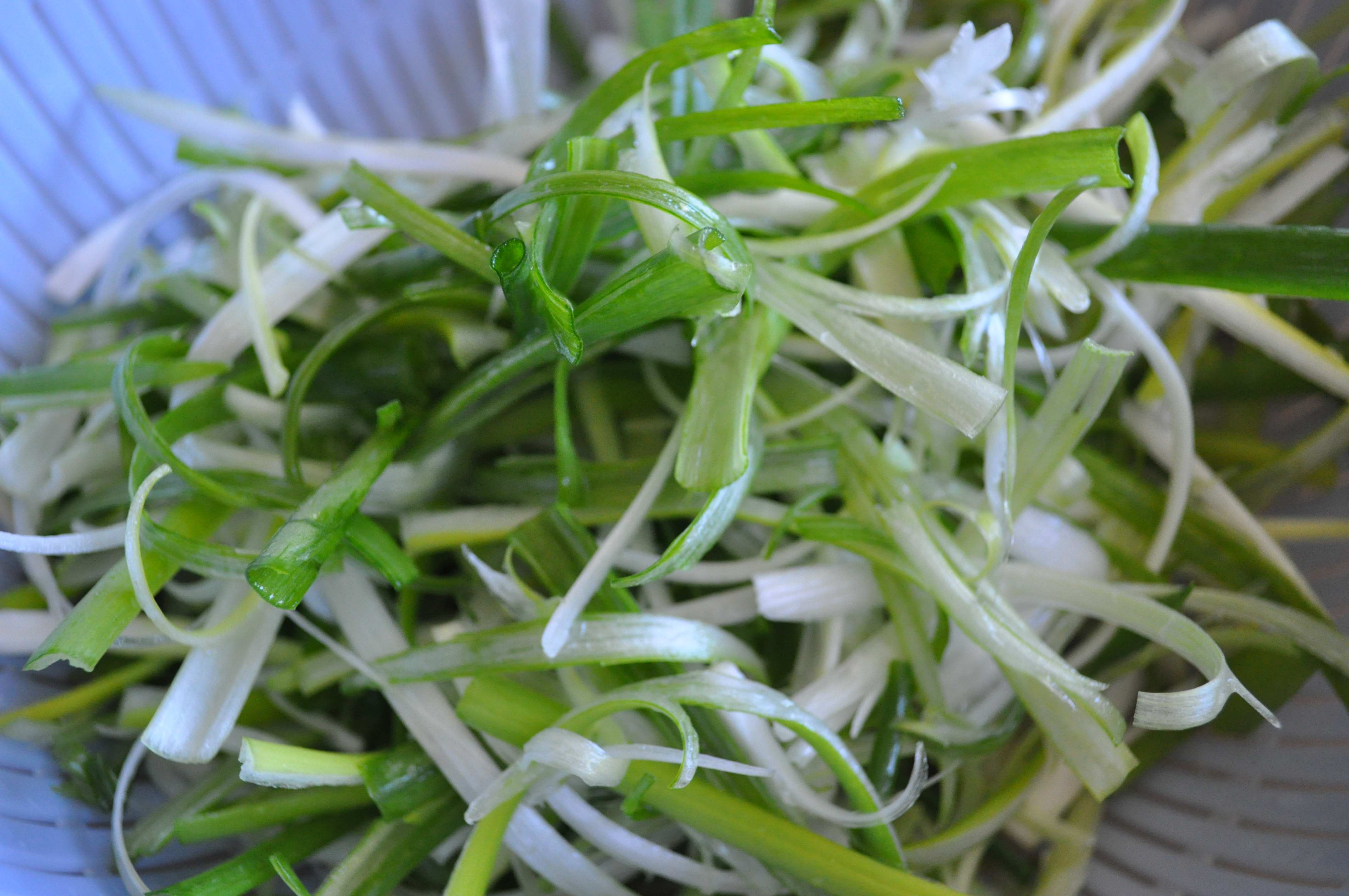
4. Wash and clean the perilla leaves. Here’s a tip for cutting perilla leaves quickly – stack a bunch of leaves (see left pic) and fold the bunch in half lengthwise and cut altogether into 3/8 in strips as you see below. You can save a lot of cutting this way!!
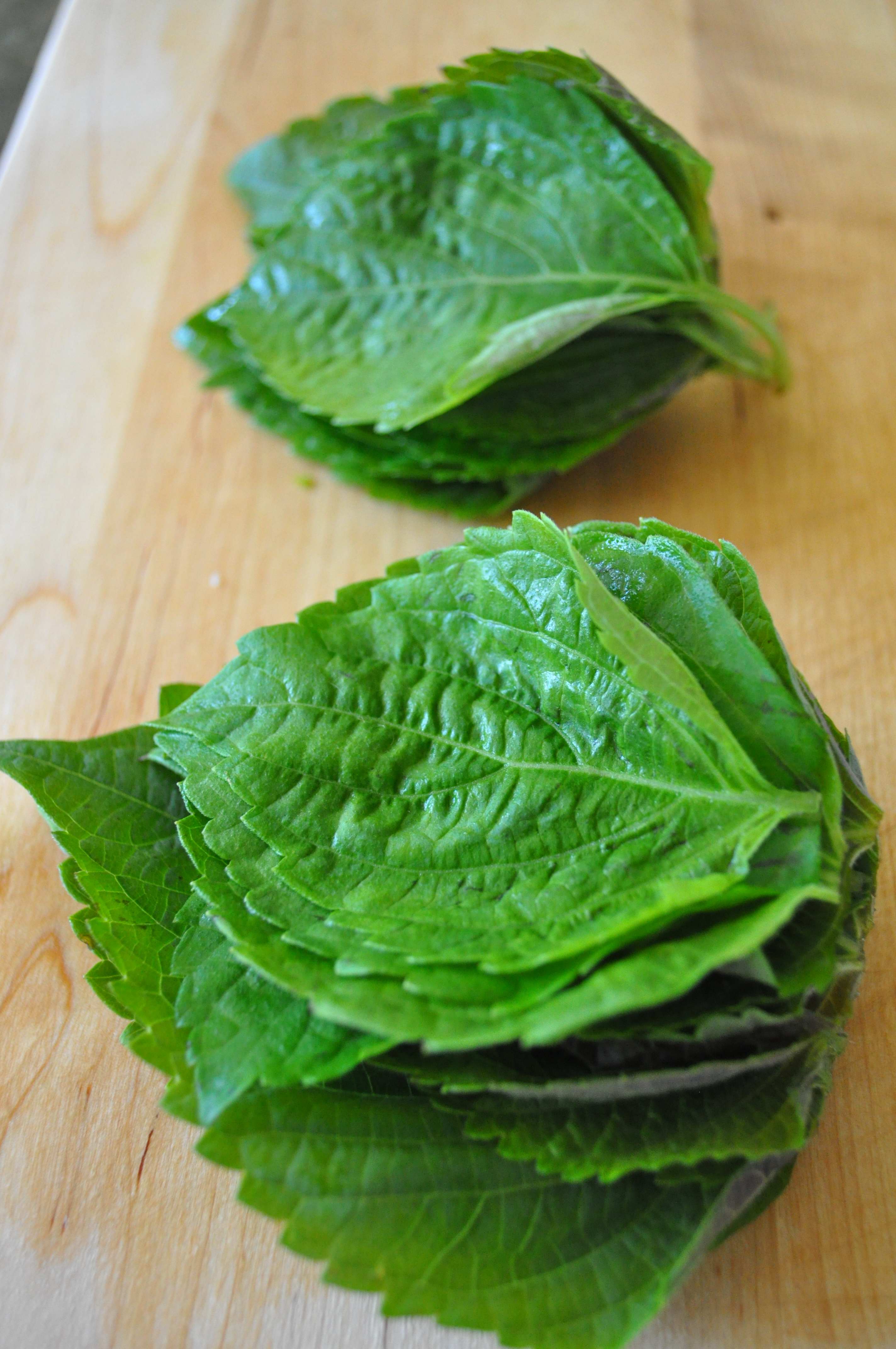
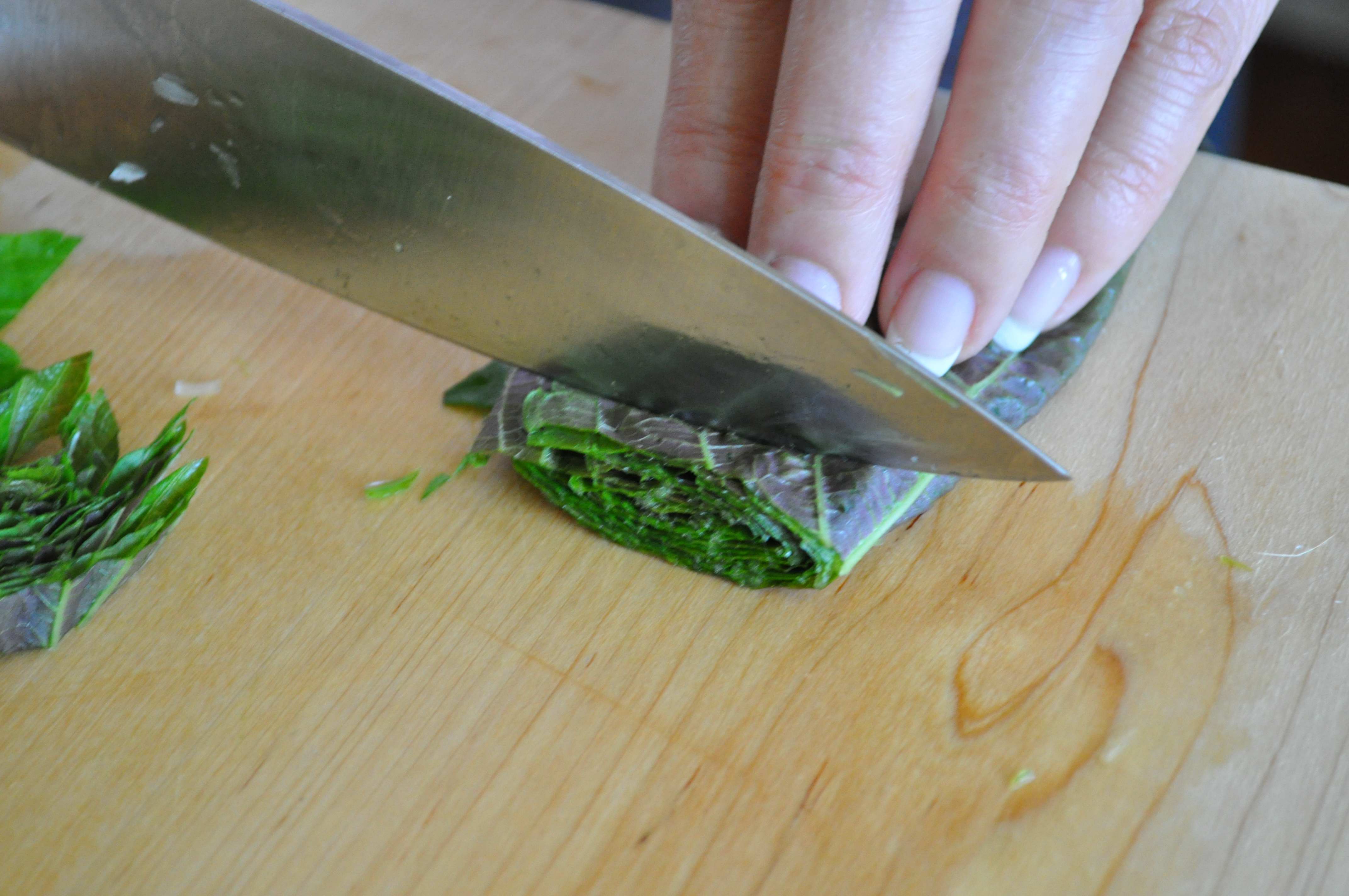

5. Make the sauce by mixing soy sauce, sugar, honey and yellow mustard. Chop some pine nuts and sprinkle on top. You can taste it and add more sugar or honey to taste. It should taste salty and sweet with a hint of spiciness!
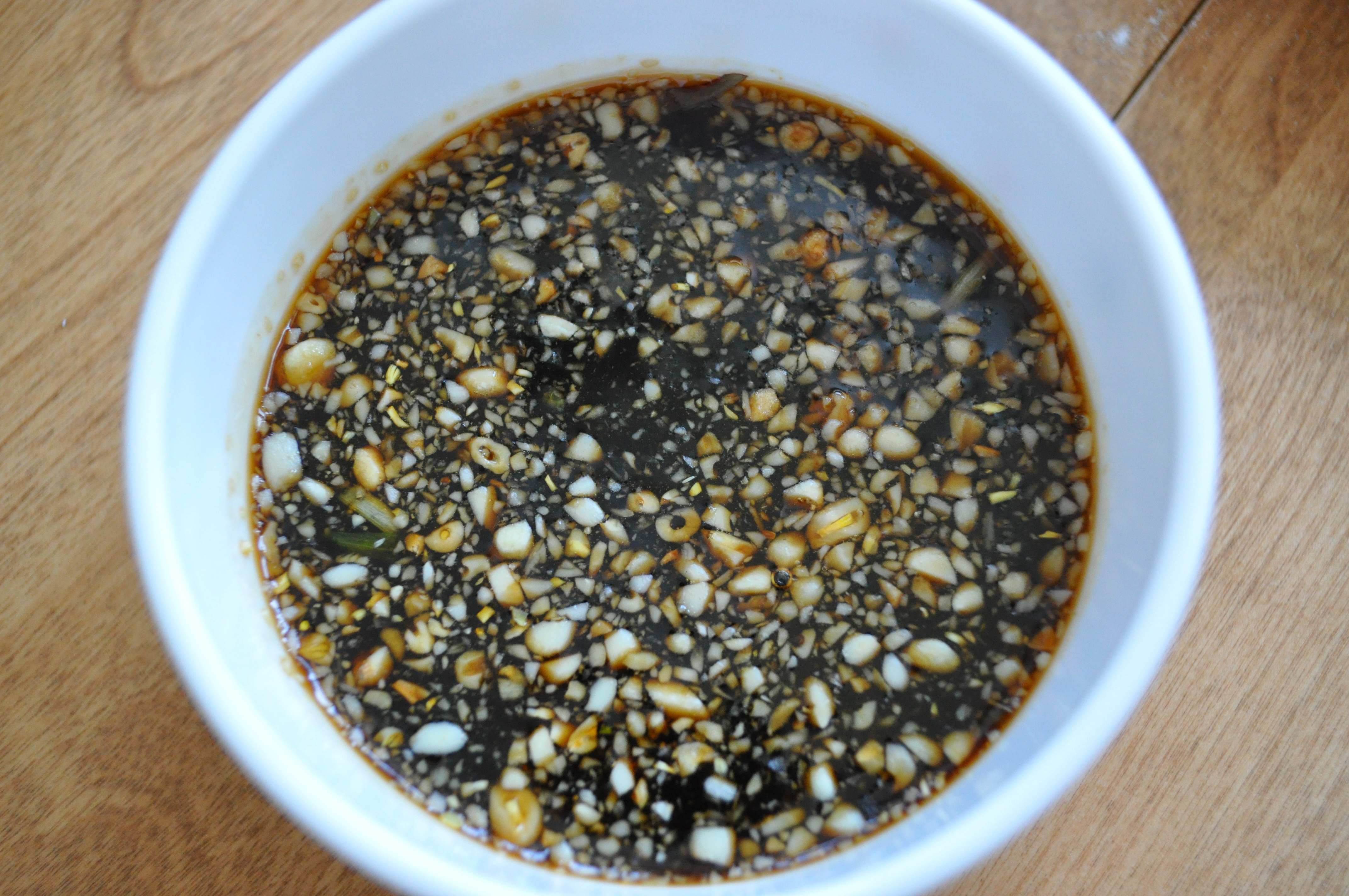
6. Now it’s time to cook the meat! Heat 2T of sesame oil in a frying pan on medium high heat. Fry each side of the beef until it’s golden brown and crispy like so…
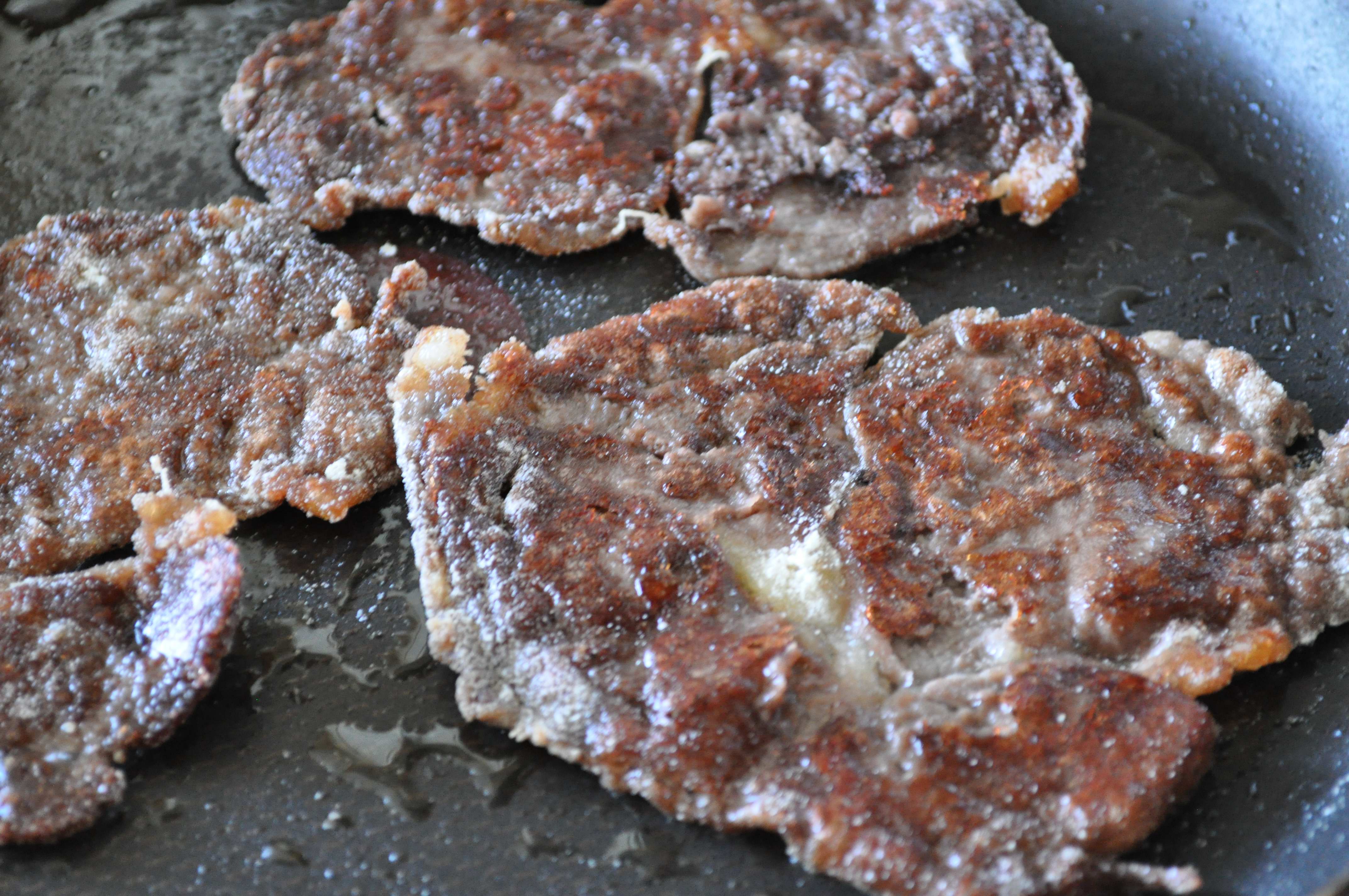
7. Serve the bulgogi, vegetables and sauce. Best way is to cook only few pieces at a time and eat while they are still warm and crispy.
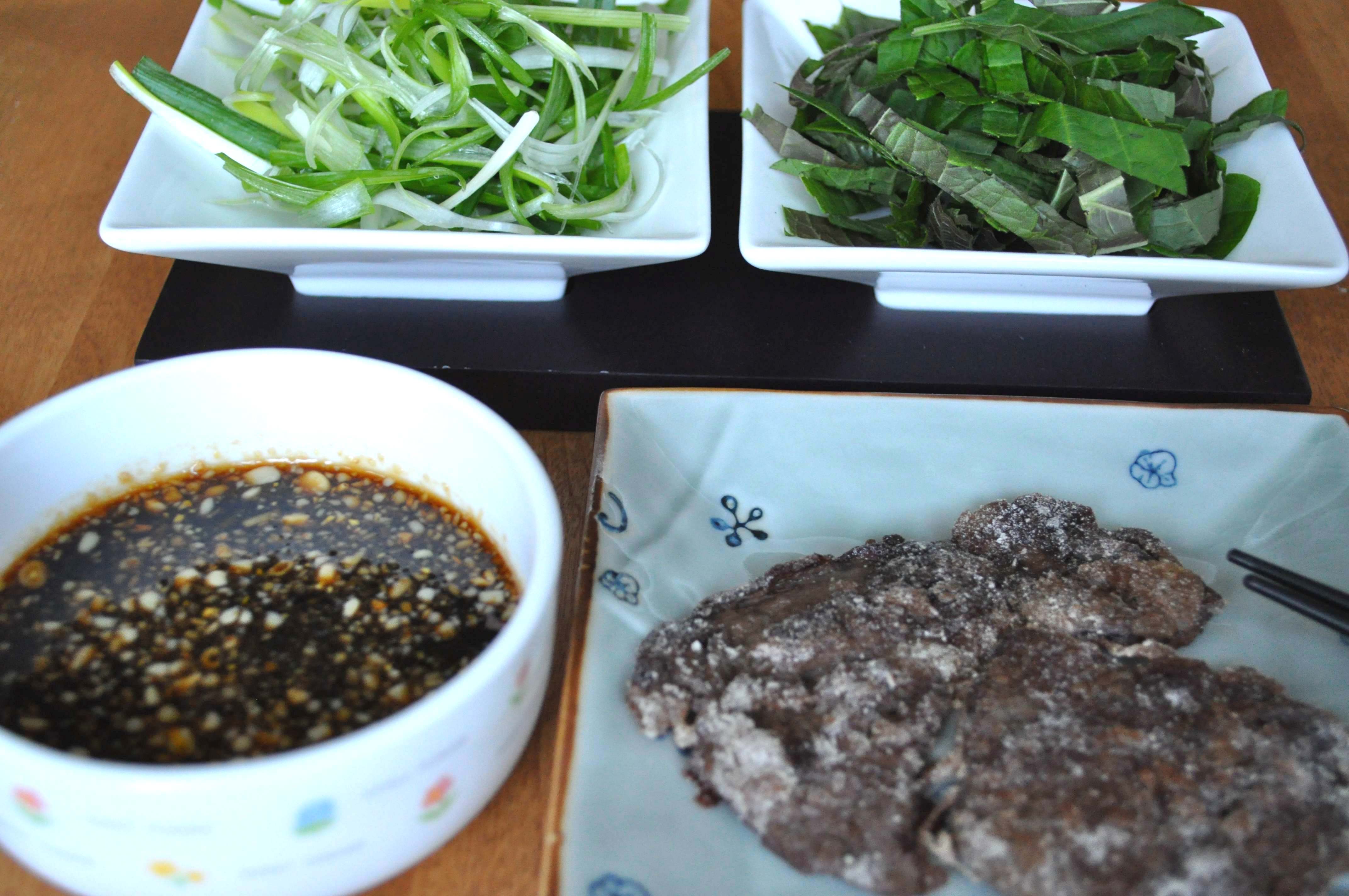
This is a truly delicious meal! And here’s how you eat it – add some vegetables in the center of the bulgogi, sprinkle some of the sauce on top as shown here:
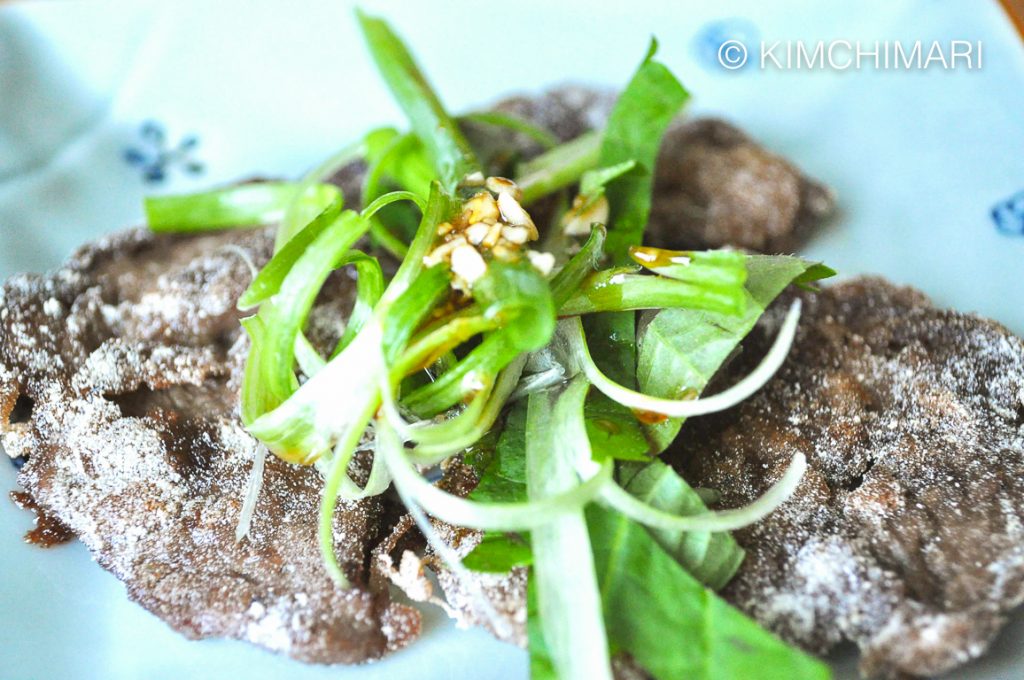
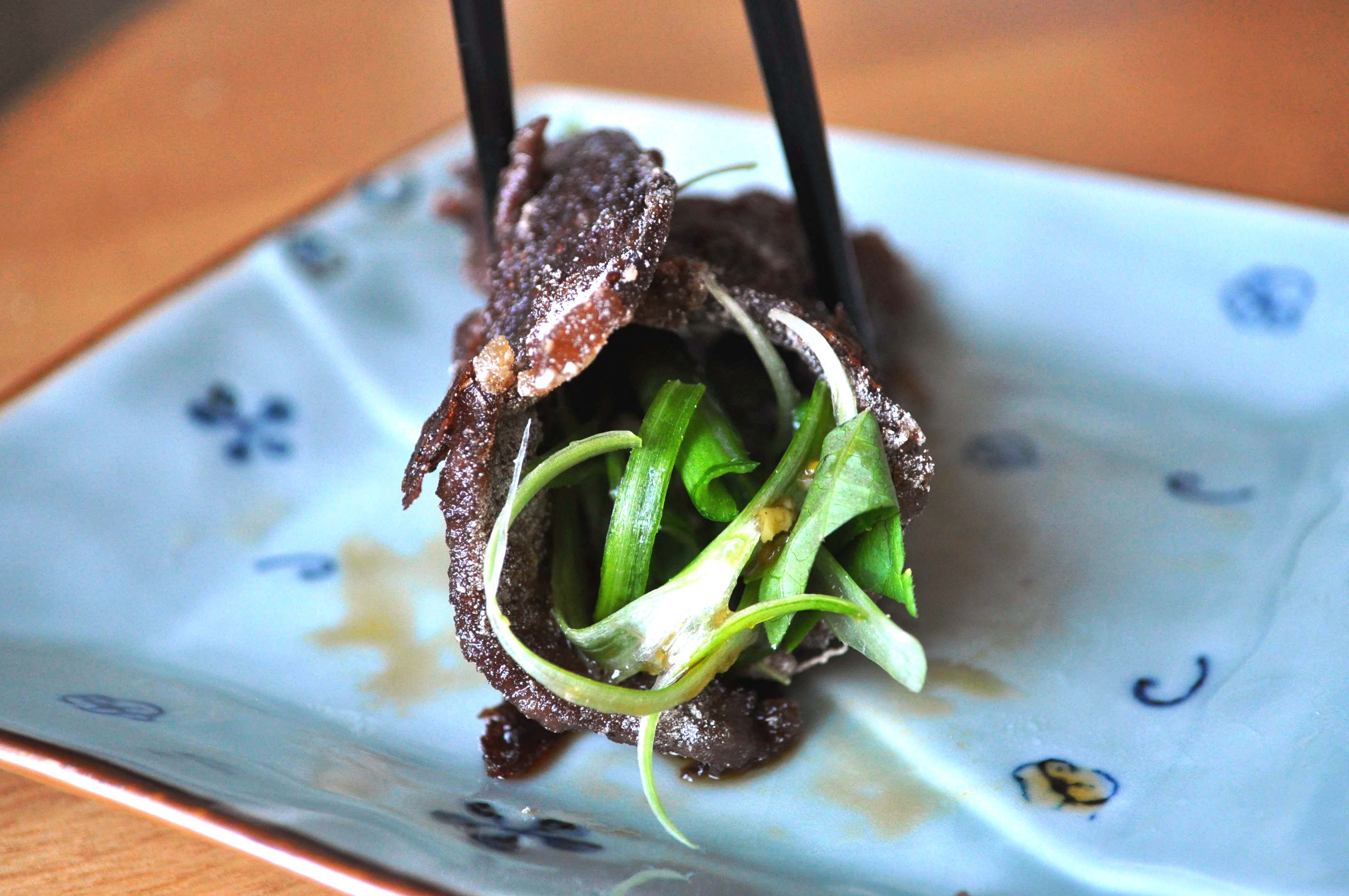
Now wrap the bulgogi into a roll, hold it with your chopsticks and in goes the chapsal bulgogi into your mouth!
Green onions is a must but you can try other vegetables such as green or iceberg lettuce, julienned carrots, radish sprouts and ssukat(crown daisy). Serve with rice and kimchi, perhaps some jjigae and you have a meal fit for any occasion!
Sweet Rice Bulgogi (Chapssal Bulgogi)
Ingredients
- 1 lb thinly sliced top sirloin or other tenderloin
- 2/3 cup sweet rice flour (just need enough to coat)
- 6-8 green onions (thinly sliced)
- 1 cup perilla leaves, sliced (optional)
- Sesame oil for pan frying
- Salt and pepper
Ingredients for Sauce
- 3 Tbsp soy sauce (Kikkoman)
- 1 Tbsp sugar
- 4 tsp honey
- 1/4 - 1/3 tsp oriental hot mustard (made from mixing yellow mustard powder)
- 1 tsp pine nuts, chopped
Instructions
- Season the thinly sliced sirloin pieces (cut for bulgogi) with salt and pepper. It’s easiest to start when the pieces are still a bit frozen where the individual pieces are still stiff but defrosted enough that each piece falls apart easily. Season each piece by sprinkling some salt and pepper onto them and layering them onto a wide plate.
- Once all the beef pieces are seasoned, coat each piece in sweet rice flour and set aside. The product I use is Koda Farms, Mochiko flour. You can find this in both oriental and American supermarkets.
- Chapsal bulgogi tastes best when it’s hot so it’s a good idea to prepare the vegetables and the sauce before you start cooking the meat. If your meat is too frozen, you can work on the sauce and veggies even before you coat the meat.
- Wash and clean the green onions. Thinly slice the green onions by cutting them into approx. 2 in long pieces and then slicing each piece thinly. This is not the only way to do it but I found (over the years) this is one of the easiest and quickest way to do it. This is called (pache) and it serves as a condiment to many meat dishes.
- Soak them in cold water for 5 min. or more. Soaking takes away the strong taste of raw onions and also makes them extra crunchy. The green onion pieces will start to curl up as shown below. Drain and serve.
- Wash and clean the perilla leaves. Here’s a tip for cutting perilla leaves quickly: stack a bunch of leaves and fold the bunch in half lengthwise and cut altogether into 3/8 in strips. You can save a lot of cutting this way!
- Make the sauce by mixing soy sauce, sugar, honey and yellow mustard. Chop some pine nuts and sprinkle on top. You can taste it and add more sugar or honey to taste. It should taste salty and sweet with a hint of spiciness!
- Now it’s time to cook the meat! Heat 2 Tbs of sesame oil in a frying pan on medium high heat. Fry each side of the beef until it’s golden brown and crispy.
- Serve the bulgogi, vegetables and sauce. Best way is to cook only few pieces at a time and eat while they are still warm and crispy.
- Here’s how you eat it: add some vegetables in the center of the bulgogi and sprinkle some of the sauce on top. Now wrap the bulgogi into a roll, hold it with your chopsticks and in goes the chapsal bulgogi into your mouth!
Tips & Notes:
- Cooking time: it tastes best when you cook and eat, cook and eat… so it’s hard to say how long it takes but each piece should take no longer than 2-3 min which means you can have about 5-6 pieces cooked in about 6 min. or so.
- Green onions is a must but you can try other vegetables such as green or iceberg lettuce, julienned carrots, radish sprouts and ssukat (crown daisy). Serve with rice and kimchi, perhaps some jjigae and you have a meal fit for any occasion!
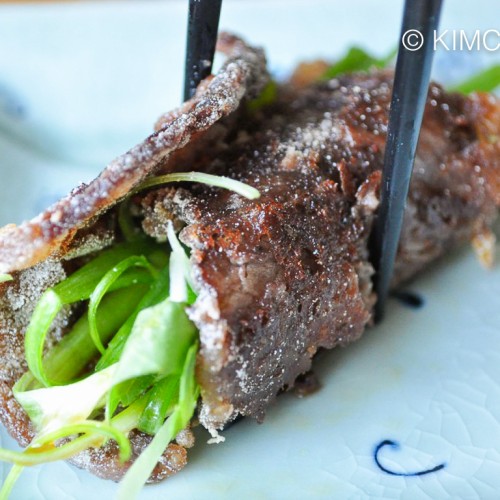
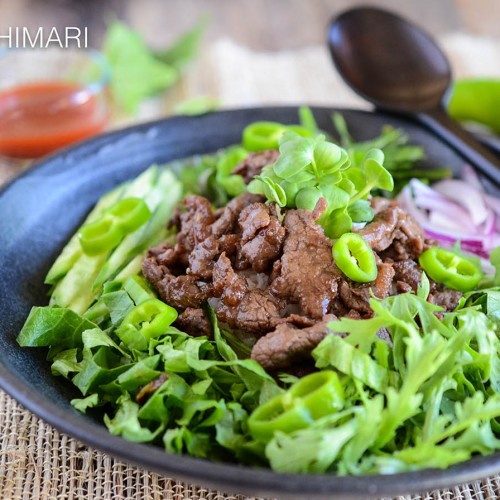

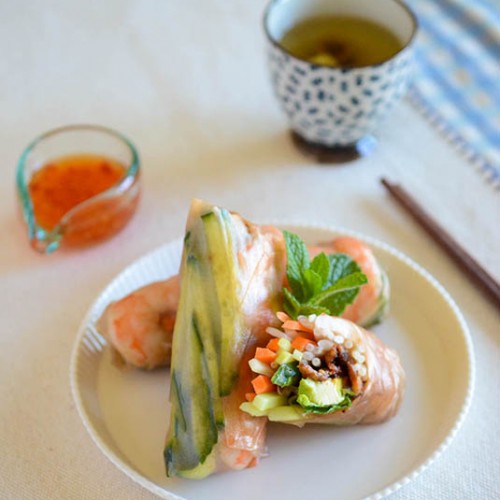
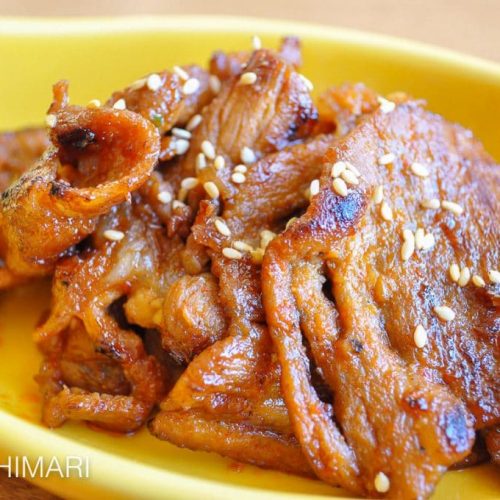
















aha! just saw this; will be picking up 고기 for this next time I go to HMart — I have everything else on hand, including an electric grill & an abundant perilla patch outside. awesome!!!
I love the idea of doing chapsal bulgogi. When pan-frying bulgogi, I always marinated the meat, but just barely before dredging in the rice flour, so that not much liquid was released during the cooking. The meat retained a little crunch. I have several different Korean hot plates that I can use with my propane stove at table side. I can’t wait to try your version of chapsal bulgogi as soon as they finish re-paving the parking lot where the Korean market is located so that I can get the perilla leaves. Gotta be authentic.
Wow you almost made it!! Yes, please do try once the Korean market is accessible. I can’t wait to hear how you like it. 😉
hi there! can’t wait to try this recipe. but quick question… what can i use instead of pine nuts? i have severe allergies. any other substitutes?
Hi! Is it just pine nuts? You could substitute chopped walnuts or other nuts. But if you are allergic to all nuts, you can certainly do without the pine nuts – it just adds extra rich flavor. Try adding some crushed roasted sesame seeds, that should be just as good. Hope it works out for you!
Hi Jinjoo,
Just found your website today by looking for a recipe for the dry shrimp in the shell. You have an awesome website! I love it! All your recipes looking delicious and the instructions are super clear with pics. to help! Thanks ever so much for putting this site up! you’re very talented, in cooking and in designing your site.
Sincerely
LC
Hello LC,
Thank you so much for your encouraging words..it really made my day! I’m glad you enjoyed visiting my site.
take care!
Hi, it’s Mimi again,
I recently bought pre-marinated bugolgi from the big H-Mart (korean market) I go to. I don’t have the grill that they have in Korean BBQ restaurants, but I figured that if I cranked the heat up high enough on my wok, that the meat would sear the same way as on the BBQ. Boy was I wrong. When I first threw the meat in, one side seared a little bit, then as the meat sat longer, it started to sweat and next thing I know, the meat was more boiling/steaming than frying. To try to burn the liquid off, I cranked up the wok to maximum heat, which did start to burn off the liquid, but at the same time, really kind of messed up my wok (I had to scrub char off the bottom for days). That’s about the part where the kitchen filled up with smoke and the smoke detector went off. Is there any way for me to cook bugolgi authentically at home with a frying pan without starting a 5 alarm fire in my small kitchen!!?
Hi Mimi!
Haha.. thank you for sharing your bulgogi mishap. smoke detectors are not fun…I know what you mean by the bulgogi boiling more than frying. Some people actually enjoy the juice that comes out of cooking bulgogi this way and they mix rice with it. But just like you, I like my bulgogi more grilled than boiled.. 🙂 Unless you have restaurant grade stove, wok is usually not going to work. So here’s how you can cook bulgogi in frying pan and not have all the juice come out: use a flat non-stick frying pan, heat the pan up on high heat first, and then add only small amount (only enough to thinly cover the pan when the meat is spread out) of bulgogi to it. The trick is to keep the heat high and cook the meat as quickly as possible. And if you do this, you will get the meat also browned. You will end up having to wipe the burnt sauce on the pan in between batches but it’s a price you have to pay if you want your meat cooked right.. 🙂 Oh and another option is to broil it on the top rack of your oven. This works fine too but you have to keep a close watch so that it doesn’t burn or gets too dry. Good luck!
Hi meemster, I have cooked things like bulgogi and samgyupsal in a george foreman grill, the juice runs off leaving dryer heat. I found it worked well. You can also buy electric hot plates/table grills, in the UK there is a grill called a bodum table grill which would work well.